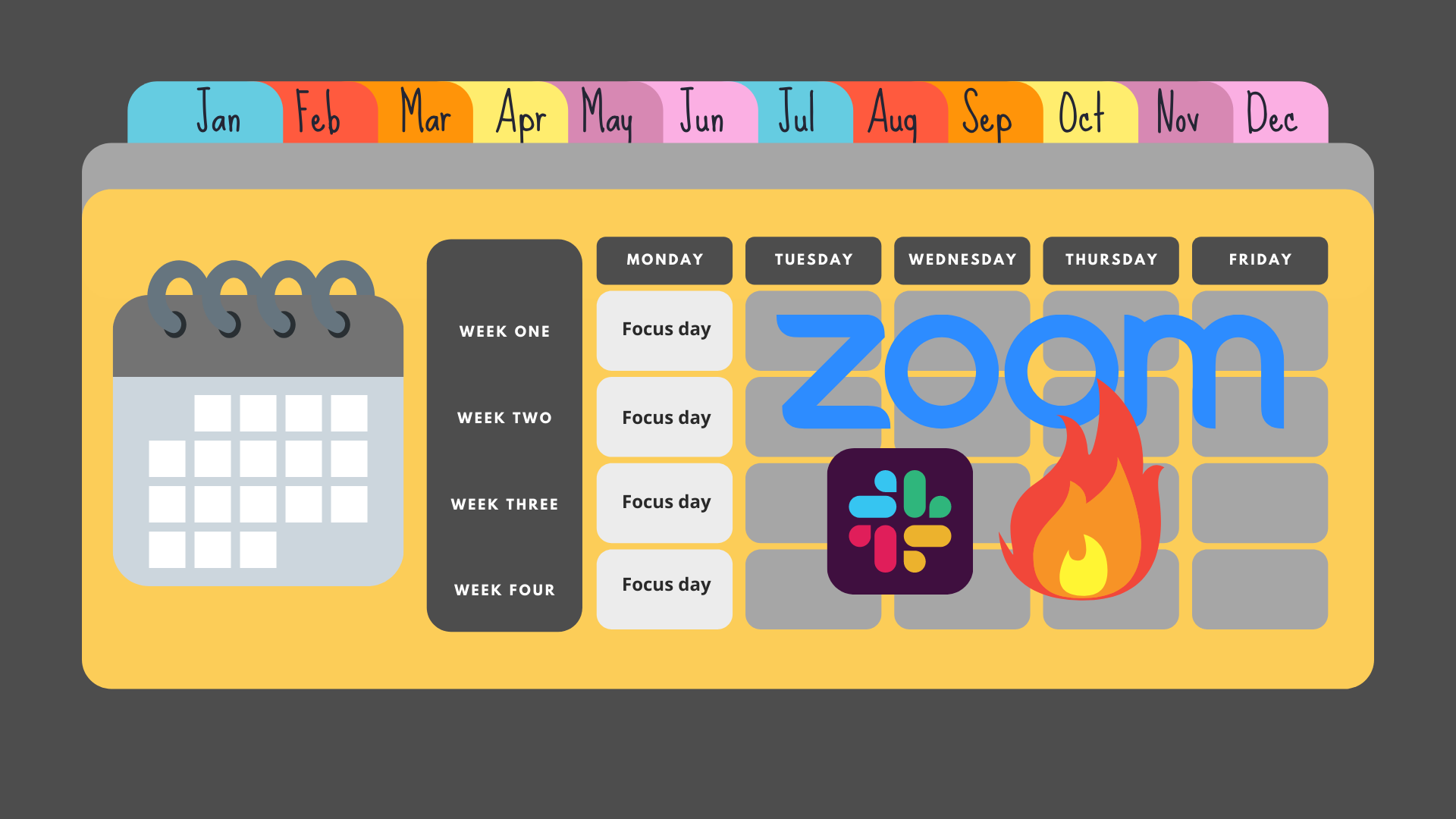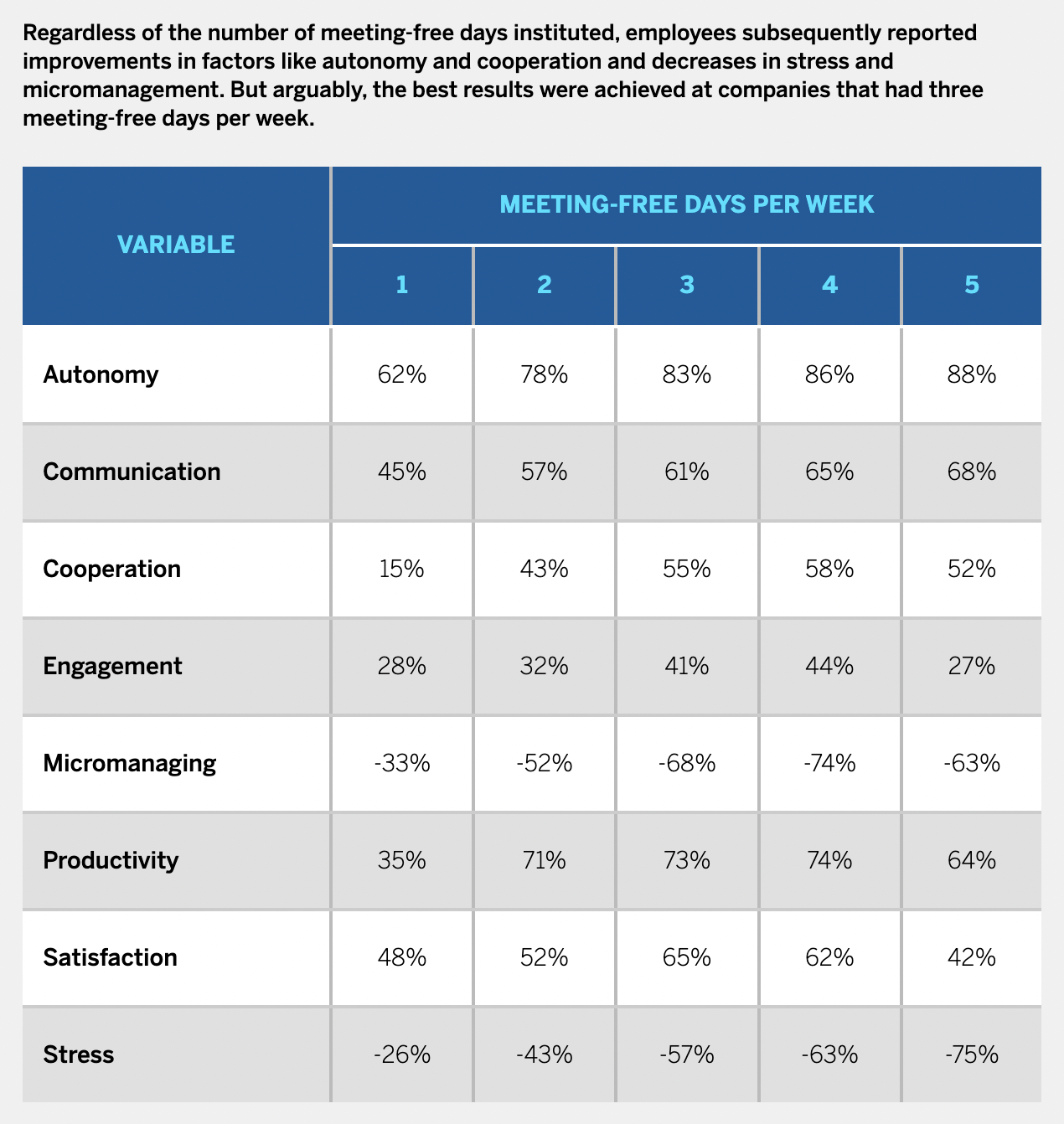Meeting Free Days
What are you willing to trade-off to give your teams the gift of deep work?

It's the dream: miles and miles of open calendar space in which to enjoy focus, achieve flow and do our best work. As meetings proliferate, companies invariably turn to more and more robust tools to carve out the space that used to seem so abundant. One particular tool with rising popularity is a no-meeting day.
It sounds great - just declare bankruptcy on anything that was scheduled, shift any truly important stuff to another day and free up everyone's time. As with anything, the devil's in the details. There are, in fact, a raft of important questions that can have a major impact on the effectiveness of no-meeting days. These include...
- How much meeting-free time is going to be impactful? Half a day, a whole day, two days? How often?
- Who is involved? Everyone? Are there exceptions? Who and why?
- What happens to customer-facing meetings?
- What about recurring meetings?
- Is a 1-on-1 a 'meeting' or not (for the purposes of this idea)?
- Will leaders set a good example?
- Will all the meetings just pop up again in text form as endless Slack chat?
The problem with cutting off everyone's meeting allowance on a particular day is that it doesn't address the original causes of meeting-bloat.
Where To Start
It's for this reason that we recommend you start with techniques to help people cancel / clear out low-value gatherings. We've found that, wherever people think the bar should be when assessing the worth of a meeting, that bar needs to be higher - sometimes a lot higher. This means asking questions like...
- What's the purpose of the meeting - can you summarize it in one verb (like 'share' or 'decide')?
- Why are there 15 people in this meeting? Are all of them essential to the meeting's purpose? How much is this costing?
- Could this meeting have been an email? Better yet, could that email have been a JIRA ticket / Google Doc / Airtable link.
- We have a huge group collaborating on this project and the synchronization cost is enormous. Would this be going faster / better, if we were clear about who owned what decisions?
In order to honor these questions (and many more besides), we need a systematic approach...
Know where you are - Do an audit
How bad is the problem? You have to know the state of the situation in order to understand the results you're looking for and the ways you'll measure success.
Consider a meeting-audit workshop in which a specific team catalogs and compares all of their individual and shared meetings. The spirit of such an exercise will be to build a heatmap of the purposes and outcomes that are being most served by the current set of meetings. If successful, it will also highlight inefficient collaboration patterns.
You needn't conduct this audit as a live meeting - it can be done asynchronously with a little forethought. Either way, you'll want to encourage people to explore...
- How many hours they spent in meetings this week.
- Whether each of those meetings started with an agenda and ended with clear action items.
- The ratio of internal meetings to external ones.
- The ratio of time spent with leadership vs. peers vs. reports.
- The amount of context switching (or, conversely, the extent to which meetings are arranged in blocks so that people can focus and achieve a flow state).
- The alignment between people's energy rhythms and their meeting times.
-
When recurring meetings are identified...
- Their length.
- Their cadence.
- Whether they could be shortened or replaced by something asynchronous.
Make better use of what you have - Tools / comms training
Think about all the tools at your disposal. There are so many ways to collaborate and communicate. We often see a direct correlation between meeting bloat and inexpert use of tools. Put simply, when people aren't skilled at communicating well in Slack (say) they tend to want to 'get everyone in a room' more. So consider things like...
-
Slack / messaging training. Topics might include...
- The features and mechanics.
- Staying sane / setting boundaries.
- Helping others stay sane.
- Hacks (scheduled send, anyone?)
-
Internal comms training. Cover fundamentals like...
- What's your message?
- Why does your message matter?
- Who's your audience?
- What channels (how) and when?
-
Async tools training. Go beyond emails and instant messaging with topics
like...
- Making and sharing video messages.
- How to structure a document with readability in mind.
- How to use comments and tasks inside docs to drive action.
You might also consider training to help people become more effective at 1-on-1s. They are an incredibly important tool and one of the deepest, most important forms of collaboration in the workplace. Getting them right can often substantially increase alignment and clarity in your organization - and that means less meetings overall.
Conduct an experiment - Limit the scope, Measure the results
As with any change, you want to avoid boiling the ocean. So ask yourself: what would a limited -scope experiment look like?
- Is there one team that might be a helpful, representative microcosm of the organization's meeting challenges?
- What are 1-3 meeting-killing principles they could adopt on a trial basis?
- What's a low-overhead way to measure the impact of those principles?
- How will you watch for displaced problems (for example, no-meeting days shifting the meeting burden to the surrounding days)?
- When will you know you're ready to expand the scope of the experiment?
Luckily for us, MIT Sloan has already conducted a study with some interesting results. They looked at 76 companies across 50 countries over a one year period who were experimenting with no-meeting days. All of them introduced 1-5 no-meeting days per week. Check out the results...

Some things really stood out...
- Part of the study found that when people have less meetings, they are more engaged with project management tools, allowing them to accurately update task statuses in a timely fashion.
- The study also found that there were far fewer misunderstandings between colleagues; people would simply check a previous Slack conversation or a project outline to review a task or request.
- The study even found a reduction in phrases like "I thought you told me ..." or "I was under the impression ...". In fact, those were hardly used at all. This reinforces that verbal conversations can be hard to keep up with causing key details to be missed. This is particularly true unless someone on your team is an expert facilitator.
- Another take-away was that, by introducing specific socialization mechanisms (like Donut or a team quiz night etc), you can potentially further reduce meetings that are born from an underlying need for social connection.
- Overall, the study concluded that the optimum number of meeting free days is 3 - allowing 2 days for necessary meetings and social connections to be maintained.
What Is Everyone Else Doing?
As is so often the case, it's important to borrow as many good ideas as you can if you're about to embark on a complex change with your teams. Here are some resources we've gathered as we've explored the no-meetings phenomenon...
- Atlassian's "Get $#!t Done" Day
- Citi's "Zoom-free Fridays"
- Asana's No-meeting Wednesdays
- Facebook's No-meeting Wednesdays
- Airbnb's meeting-free Wednesdays
- LinkedIn In-Days (one Friday per month)
- Moveline's "Maker Days"
- Sales Force's "Async Weeks"
Naturally, just because these ideas are working for them, doesn't mean they're right for you. Design and run your own experiment. Listen hard for the feedback from team members. Look at the data available and understand what success looks and feels like for team members when it comes to these kinds of changes. And please let us know how it goes - we'd love to hear from you.
If you're keen to dig deeper and gain more practical tools to improve your meeting culture, you might consider our Fix Your Meetings program.


